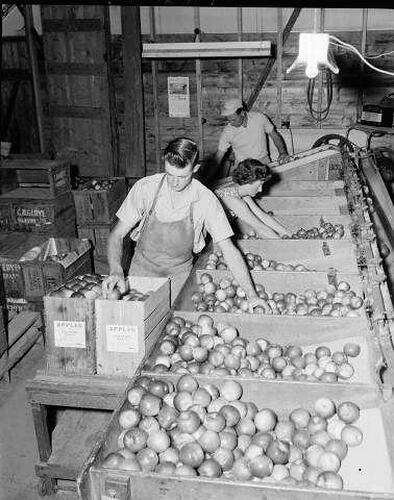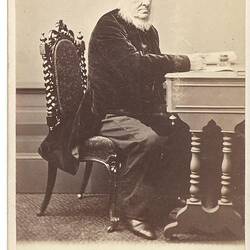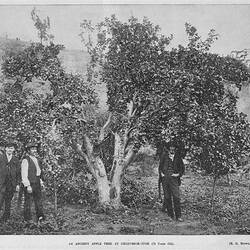Summary
The first planting of apple trees was recorded by Edward Henty in October 1834 at the first Victorian settlement at Portland. Soon after, orchards were planted around Melbourne and remained close to the growing township until the discovery of gold which led to an expansion of apple plantings into other parts of the colony in the 1850s. From then on, orchards spread across the state but remained more or less in five main commercial apple growing areas which are still the same today: Stanley/Beechworth, the Goulbourn Valley, Harcourt, Bacchus Marsch, the Yarra Valley, and Gippsland. The reasons for where apples were planted are complex and depend on physical factors, economic and market conditions as well as cultural and social contexts, demonstrating the very intricate relationship between humans and their environment.
Apples are grown all over Victoria, but the main commercial apple growing regions are: Stanley/Beechworth, the Goulbourn Valley, Harcourt, Bacchus Marsch, the Yarra Valley, and Gippsland. Not only because the climate or soil can support this temperate crop but also due to social and cultural reasons. In Victoria, growing fruit trees was a part of colonial life right from the beginnings of settlement in the 1830s, as shown in the diary of Edward Henty of Portland where he writes on 10 October 1934 that he planted 'raspberries, strawberries, apples, gooseberries and grapes in the garden' (Learmonth, 1934).
Soon after in 1835 John Pascoe Fawkner arrived from Hobart in Tasmania, bringing with him a great variety of seeds and plants. Thirteen years later his orchard at Pascoevale boasted a wide selection of pomme fruits, berries, stone fruits and vines, including 35 varieties of apples (Winzenried, 1991). John Batman also introduced many plants from his home in Tasmania to his new residence at Batman Hill where a garden and orchard was established (Brown, 1966, Draper, 2006, The Evelyn Observer, 1890).
One of the remnants of Batman's tree collection still stands today and is known as the Batman Apple Tree at Greensborough. Mr Whatmough of Greensborough established an apple orchard comprising many of his own species, but also some of the original specimen from Batman, including the apple tree still standing today (The Evelyn Observer, 1890). This legendary tree is thought to have been a Winter Majetin apple, but over the years different varieties have been grafted on to the old tree, including Rymer and Rome Beauty (Draper, 2006). However, the more popular belief is that the original apple variety was named after the orchardist who was responsible for passing it on to the Museum of Victoria in 1875 for modelling, resulting in the name of Whatmough's Fancy (also see Whatmough Collection).
Orchards were planted in a variety of regions, all physically able to support the growing of apple trees but varying in the proximity to markets, differing in technologies and transport available, as well as having diverse demographics, ever changing and never static. As Melbourne's population increased, so did the requirement for fresh vegetables and fruit. Market gardens and orchards began to form on the fringes of the township and by the 1850s the eastern outskirts, today's suburbs of Doncaster and Templestowe, were home to Victoria's first commercial orchards and by 1860 there were 50 acres of orchards in the area (Cowles and Walker, 2005, Green, 1985).
The discovery of gold had a major impact on the development of Victoria. The dramatic increase in population, from 77,000 in 1851 to 540,000 in 1861 (Connor and Smith, 1987, Garden, 1984), coupled with the fact that most gold fields were located in areas where settlement was not yet established, heavily impacted on all sectors of society, including the apple industry. While in the early 1850s many farmers abandoned land to flock to the gold fields of Ballarat and Bendigo, the later part of the decade was a boom period for existing growers around the major cities and close to the goldfields where demand for fresh fruit and vegetables was high (Garden, 1984, Holman, 1993). So high was the demand, that Victoria had to supplement its fruit and vegetable supply by importing produce from other parts of Australia.
However, by the 1860s Victoria was more or less self sufficient in terms of fresh produce supply (Henzell, 2007). Bacchus Marsh and Harcourt are good examples of how the discovery of gold attracted new settlers, and as work progressed and water supply was improved to provide water for mining activities, agriculture and horticultural developments were able to be established.
The depression of the early 1890s saw the opening up of land on the Mornington Peninsula near Red Hill as well as in Gippsland to provide opportunities for the 'deserving poor' (Garden, 1984), also coinciding with the beginnings of orcharding in those areas. And it was the large scale irrigation scheme of the Murray and Darling rivers, that initially allowed an expansion of orchards into the Goulbourn Valley in the late 19th century (Henzell, 2007).
Today's area of Doncaster is no longer a spring-time attraction where families went for a weekend outing to marvel at the sea of apple blossoms. It has now been transformed into a compact residential suburb with only street names dedicated to the orchard pioneers reminding us of the once successful apple industry. Many of the orchards moved further east into the Yarra Valley, now one of the big orcharding areas in Victoria. Other areas, such as Harcourt, Bacchus Marsh and the Mornington Peninsula are still apple growing regions but are now competing with other land uses such as residential development or vineyards.
While gold may have been the initial trigger for development, it was technologies such as irrigation and transport that enabled orchards to survive and develop. At the same time, had it not been for the suitable soils and climate, the apples would not have been able to thrive. But most importantly for survival of the industry, apple growers need a market to sell their produce, locally, nationally as well as internationally. With 43% of apples grown in Victoria, the state is Australia's biggest apple producer (Australian Bureau of Statistics, 2012). The history of apple orcharding in Victoria reveals the interconnectedness between people and the environment and shows that neither stands alone.
References
Australian Bureau of Statistics 2012. Agricultural Commodities, Australia.
Brown, P. L. 1966. John Batman (1801-1839) Australian Dictionary of Biography. National Centre of Biography, Australian National University.
Connor, D. J. & Smith, D. F. 1987. Agriculture in Victoria Parkville, Vic.: Australian Institute of Agricultural Science, Victorian Branch, 1987.
Cowles, C. & Walker, D. 2005. The Art of Apple Branding, Hobart, Apples from Oz.
Draper, B. 2006. Victoria's oldest apple tree? [Known as Batman's Apple Tree, this productive oldtimer is said to have links with Melbourne's colourful founder.]. Australian Garden History, 18, 20.
Garden, D. 1984. Victoria, a history, Melbourne, National Library of Australia.
Green, I. 1985. The orchards of Doncaster and Templestowe, Melbourne, Doncaster - Templestowe Historical Society.
Henzell, T. 2007. Australian agriculture: its history and challenges, Collingwood, Vic. : CSIRO Publishing, 2007.
Holman, A. 1993. William Behrens, Sign Publishing Company.
Learmonth, N. F. 1934. The Portland Bay settlement : being the history of Portland, Victoria from 1800-1851 / by Noel F. Learmonth; with a foreword by A.S. Kenyon, Portland, Vic.: Historical Committee of Portland, 1934.
The Garden of Victoria. 1890. The Evelyn Observer, and South and East Bourke Record (Vic.: 1882 - 1902), p.3.
Winzenried, A. 1991. Green grows our garden: a centenary history of horticultural education at Burnley / A.P. Winzenried, South Yarra, Vic: Hyland House, 1991.
Other useful reading
Australian Apple and Pear Limited (www.apal.org.au)
Aussie Apples (www.aussieapples.com.au)
More Information
-
Keywords
-
Authors
-
Article types




